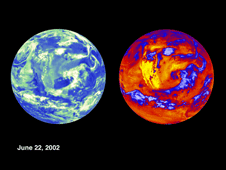 NASA’s Langley Research Center’s Clouds and the Earth's Radiant Energy System (CERES) instruments have been observing clouds and the radiation budget for nearly a decade now. Key questions remain about how a warming climate will affect clouds, which play an important role in what scientists call the planet's "radiation budget."
NASA’s Langley Research Center’s Clouds and the Earth's Radiant Energy System (CERES) instruments have been observing clouds and the radiation budget for nearly a decade now. Key questions remain about how a warming climate will affect clouds, which play an important role in what scientists call the planet's "radiation budget."
Since its inception, CERES, which measures all wavelength radiation, has gathered that important data, building on the prior observations of NASA’s Earth's Radiation Budget Experiment (ERBE) data to create a 30-year record of radiative flux at the top of Earth's atmosphere.
A new sensor, the CERES Flight Model (FM) 5, that will continue the 30-year climate data record of the Earth's radiant energy, has been delivered ahead of schedule and on budget, by Northrop Grumman Space Technologies. The CERES FM 5 instrument will fly as part of the National Polar-orbiting Operational Environmental Satellite System (NPOESS) Preparatory Project (NPP) in 2010. Four CERES sensors currently operate on NASA's Terra and Aqua Earth Observing System spacecraft.
"We were given authority to proceed in January '08, and we delivered in Nov. '08," said CERES co-Principal Investigator Norman Loeb. "That, to me, is a really spectacular success story."
The "radiation budget" is an ever-changing exchange of incoming solar radiation and outgoing radiation that is either emitted by Earth or reflected by the Earth's surface, clouds and aerosols. The amount of energy fluctuates, but the "budget" is always in near-balance, meaning incoming and outgoing radiative fluxes are approximately equal. Changes in this budget largely determine the Earth's temperature and climate.
The CERES instruments detect the amount of outgoing heat and reflected sunlight leaving the planet. An example of CERES data from CERES Aqua show measurements over the United States from June 22, 2002. CERES detects the amount of outgoing heat and reflected sunlight leaving the planet.
Clouds play a significant, but still not completely understood, role in the Earth's radiation budget. Low, thick clouds can reflect the sun's energy back into space before solar radiation reaches the surface, while high clouds trap the radiation emitted by the Earth from escaping into space. The total effect of high and low clouds determines the amount of greenhouse warming.
When scientists build computer models that predict how Earth's climate will change over time, figuring out what role clouds play in the radiation budget and how cloud behavior might change due to a warming planet is an important task toward accuracy.
"The Earth's radiation balance is in many ways the most critical part of the climate system and is directly influenced by changes in atmospheric composition, such as greenhouse gases and aerosols, cloud properties, and surface and atmospheric temperature," said Loeb. CERES co-Principal Investigator Bruce Wielicki noted "The long climate record from CERES will ultimately answer a longstanding question in science concerning the role of clouds in amplifying or damping the sensitivity of the Earth's climate system."
Data indicate that clouds have an overall cooling effect on the planet. But many other questions remain about what a changing climate will do to cloud behavior, and how exactly clouds affect climate and seasonal weather. The role of clouds remains the largest source of discrepancy among climate models, underscoring the importance of both continuing to observe clouds and their relationship to the radiation budget, and using CERES data to refine the role of clouds in climate models.
Monday, November 24, 2008
Cloud and Climate Changes: CERES Flight Model Moves toward Launch
Labels:
Global Warming
Subscribe to:
Post Comments (Atom)

No comments:
Post a Comment